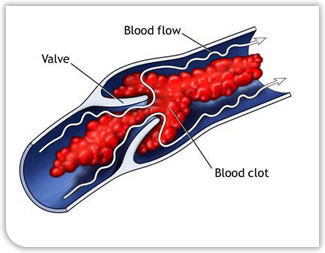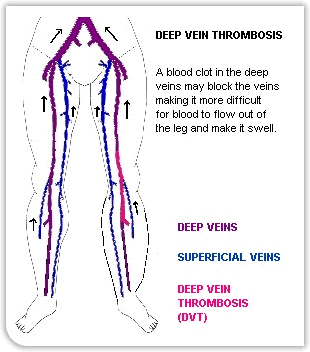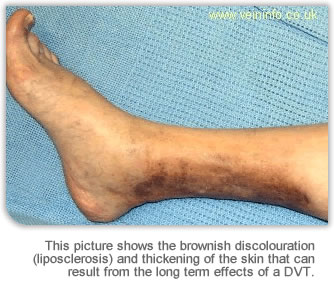What is Deep Vein Thrombosis DVT?
 The heart pumps blood around the body.
The arteries take blood from the heart to the places it is needed
and the veins take it back to the heart.
The heart pumps blood around the body.
The arteries take blood from the heart to the places it is needed
and the veins take it back to the heart.
There are two major sets of veins in the body, the deep veins which are deep inside the muscles and the surface (superficial) veins which are the ones which you can see under the skin and which sometimes form varicose veins. The deep veins are larger and more important than the surface ones. A deep vein thrombosis is a blood clot occurring in one of the deep veins, most commonly in one of the leg veins.
Why does DVT happen?
It is very important that blood does clot when necessary, otherwise even a small cut would lead to serious loss of blood. On the other hand, if blood clots in the wrong place this too can cause serious problems. It has been known for about 150 years that there are three main things that increase the chance of a blood clot forming.
- Damage to the veins themselves; (for example, breaking a leg may damage the veins in the leg);
- Increased "stickiness" of the blood; (for example, dehydration increases the tendency of blood to clot, so does pregnancy and injury. Some medical conditions also make blood clots more common, for example some types of cancer, some people have abnormalities of the clotting systems themselves which make clotting more likely;
- Decreased blood flow through the veins. The main thing that makes blood flow through the veins is using the muscles around the veins. If you are immobile, for example after an illness or an operation then you are at increased risk of a clot.
Often several of these factors come together, for example if you break a leg you may damage the veins, have increased stickiness of the blood because of your injury and be immobile because it hurts to use the muscles of the leg.

What problems can DVT cause?
As methods of detecting DVTs improve it has been realised that minor clots are much commoner than was once thought and that many of them never cause any trouble and are reabsorbed by the body with no long term effects, the person who has the clot may experience no symptoms at all and not know that they have had one. Probably many DVTs cause no problems whatsoever.
If DVTs do cause problems then there are two main areas to consider early problems and late problems.
What are the possible early problems from DVT?
I: Problems in the leg
 A DVT
causes inflammation. This may make the leg feel hot, tender and swollen and look red. It also blocks off the vein
making it more difficult for blood to get out of the leg which also causes swelling. This is not particularly reliable as
some DVTs cause no symptoms and other things, for example, an infection can also cause inflammation and produce a
similar picture.
A DVT
causes inflammation. This may make the leg feel hot, tender and swollen and look red. It also blocks off the vein
making it more difficult for blood to get out of the leg which also causes swelling. This is not particularly reliable as
some DVTs cause no symptoms and other things, for example, an infection can also cause inflammation and produce a
similar picture.
In general, the bigger and further up the leg the DVT is the more obvious is the effect on the leg. Sometimes some of the blood clot in the vein can be dislodged and be carried up with the blood returning to the heart to the lung. This is the cause of the second major area, problems in the lung.
II: Problems in the lungs
If a bit of clot breaks off from the leg veins and gets carried up to the veins to the lung it is known as a pulmonary embolus or PE. The effect of this depends on how big the clot is and how many of them there are. A single small PE may cause no symptoms at all. As the amount of clot gets bigger it may cause shortness of breath and pain on breathing and sometimes coughing up blood. A massive PE may block the circulation completely and stop the heart from being able to pump blood around the body causing sudden death.
What are the possible late problems from DVT?
 Some people have no long term effects from DVT.
Some people have no long term effects from DVT.
The main potential long term problems from DVT are caused by the effects of the clot on the veins in the leg. In the early stages, the veins may be blocked by the clot, making the leg swell up. Usually, the body reabsorbs some of the clot which unblocks the vein.
However, when you are standing up, blood has to flow uphill from the legs to get back to the heart. To do this it relies on one way valves in the veins. When you walk, the muscles squeeze the veins, pushing blood upwards. When they relax, the one way valves stop the blood coming back down.
The effect of this is to work as a pump pushing blood upwards to the heart. A DVT can permanently destroy some or all of the one way valves in the legs stopping the pump from working properly. As a result there is a permanently high pressure in the veins in the leg which causes the leg to swell and damages the skin. In the early stages this shows as a brownish colour in the skin around the ankle, later on this may progress to ulceration.
 Contact Me
Contact Me